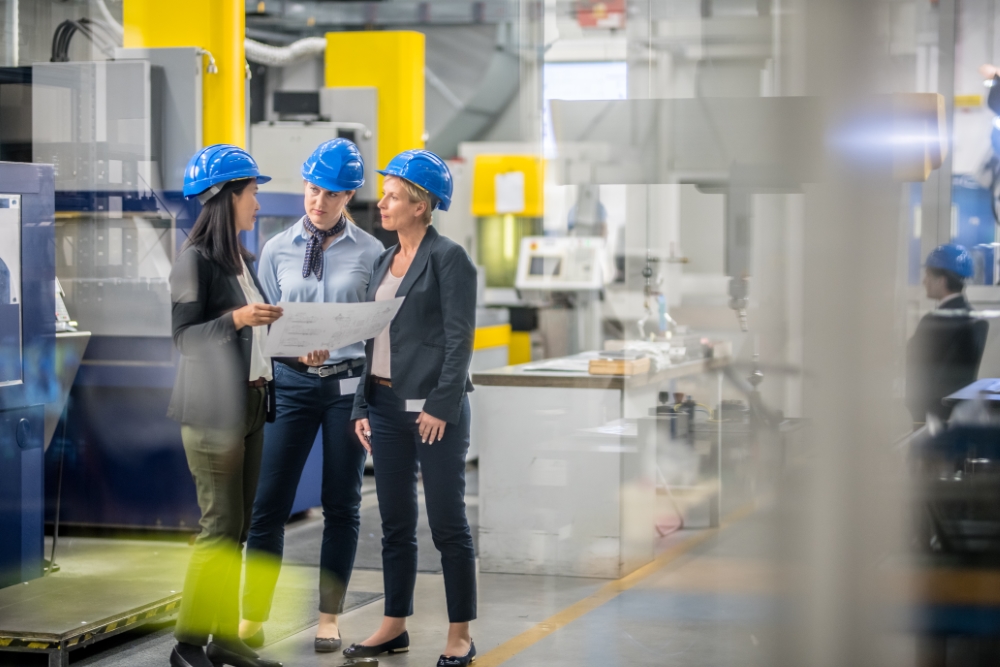Women in Manufacturing
While the manufacturing industry has seen significant growth in female employment in recent years, the gap between male and female workers — especially in leadership roles — remains wide. Women make up only 30% of the manufacturing workforce and hold nearly a quarter of management positions in the U.S.
U.S. Under Secretary of Commerce for International Trade Marisa Lago opened the Women in Manufacturing panel at the 2024 SelectUSA Investment Summit last June by sharing this fact, followed by a blunt truth:
“We have got to do better.”
This call to action set the tone for a compelling discussion featuring three trailblazing women across varying sectors of the manufacturing industry; Belén Garijo, CEO of Merck KGaA; Panasonic Corporation of North America Chairwoman and CEO Megan Myungwon Lee, ; and Beatrix Praeceptor, CEO of Greiner Packaging International GmbH.
Each of these women took a unique journey to achieve their success. Lee, an immigrant from Seoul Korea, began her career in HR. Praeceptor worked various jobs related to supply chain management. Garijo was previously employed in the former German government advising on European policy.
“As a child, I always said I wanted to work in an environment where I can touch what I produce,” said Praeceptor. “At the end of the day, it didn’t matter whether it was a TV or it was concrete or cement — now it’s packaging. It’s always about having a customer who wants something and the company I work for, which produces it, you can see that bringing people together, putting processes in place, working along that value, can really create something.”

“You can see that bringing people together, putting processes in place, working along that value, can really create something.”
— Beatrix Praeceptor, CEO, Greiner Packaging International GmbH
Breaking Barriers
Just as there was no single path to success for these women, there are now more opportunities than ever before for women to create careers in manufacturing in. As this sector has evolved, innovation has rewritten what work in this industry looks like, shedding the dated stigmas that manufacturing is a dirty, male-dominated field.
“There’s a revolution in innovation. Manufacturing is smarter, cleaner and safer. So, this perception that it requires more physical elements has changed,” said Lee. “There’s a lot more technology and innovation adapted to manufacturing, and we’re seeing a lot more automation in process as well. We need to pay attention to this trend to make sure that we become part of it, so that we provide a work environment that’s more inclusive.”
The panelists discussed the various ways companies can work to achieve this.
Lee underscored how partnerships with educational institutions and organizations can be a driving force for change.
“Early exposure to technology and STEM learning as well as role models is really important. We’re partnering with an organization called Million Girls Moonshot, providing after-school and out-of-the-classroom experiences with our female engineers for the younger female students.”
Garijo touched on the importance of being adaptable and considering the different sitations that may be keeping women from entering the workforce.
“We also need to talk about child care aspects in terms of their career paths. You need to talk about how models can actually be set up for families who are both working full time. This is something that can be used to maintain that diversity.”
Praeceptor emphasized the critical need to actively listen to employees in order to cultivate a work environment that is both fulfilling and empowering. “What turned out to be extremely powerful, we have a sort of standard online meeting network, which is called Data For All, which is basically a curious community of people who get together and discuss what are the things that need to be done within our company to make it more inclusive,” she shared. “I think listening to the people, to what is needed to feel included, to have a sense of belonging to a company, creating this kind of environment, will solve most of the issues for women, of course, but also for other minority groups.”
By embracing the evolution of the industry — where technology, automation and a more inclusive work environment are at the forefront — companies can ensure that more women not only have a place in manufacturing but are empowered to lead. As the industry continues to evolve, so does the way companies cultivate their work environment.

